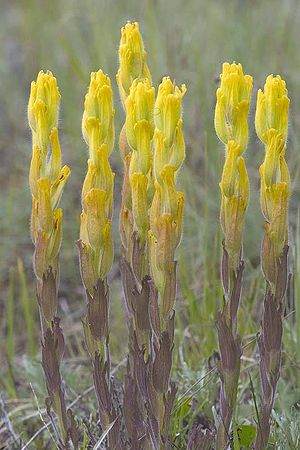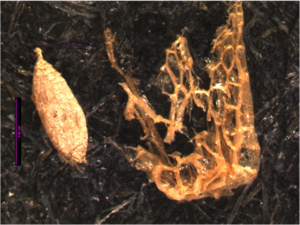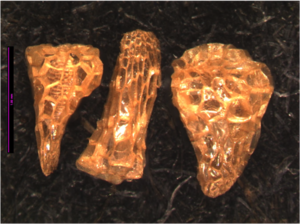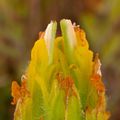Castilleja levisecta
- Latin Name: Castilleja levisecta
- Family: Orobanchaceae
- Common Names: golden paintbrush
- Codon: CASLEV
| Castilleja levisecta | |
|---|---|

| |
| Photo by Rod Gilbert, also featured on Main Page | |
| Scientific classification | |
| Kingdom: | Plantae |
| Subkingdom: | Tracheobionta |
| Phylum: | Spermatophyta |
| Subphylum: | Magnoliophyta |
| Class: | Magnoliopsida |
| Family: | Scrophulariaceae |
| Genus: | Castilleja Mutis ex L. f. |
| Species: | C. levisecta Greenm. |
Contents
Description
General: Perennial, the stems several, unbranched, decumbent, 1-5 dm. tall, softly sticky-villous. Leaves: Leaves viscid-villous, the lower ones entire, linear-lanceolate, the upper ones oblong-ovate to oblong-obovate, with1-3 pairs of short, lateral lobes on the upper 1/3 of the blade. Flowers: Inflorescence straight and upright, becoming elongate, the flowers remote and hidden by the overlapping bracts; bracts about the width of the upper leaves, oblong, obtuse, puberulent, with 1-3 pairs of short, lateral lobes near the apex, golden yellow; calyx 15-18 mm. long, deeply cleft above and below, its primary lobes again divided into 2 linear segments; corolla 20-23 mm. long, the upper lip slender, about 3-4 times the length of the lower lip; stamens 4. Fruit: Capsule.
Bloom Period
April- September
Distribution
Puget Sound of Washington; Vancouver Island south to the Willamette Valley of Oregon. The taxon is a regional endemic with a historic range west of the Cascade Mountain Range from the southern tip of Vancouver Island, Canada to Linn County, Oregon. In Washington, the species occurs in the Puget Trough physiographic province. The taxon is believed to be extirpated from the Willamette Valley physiographic province of Oregon. The southern-most extant occurrence of C. levisecta is in Thurston County, Washington.
This is a federally threatened species and an endangered species in Washington.
Habitat
Meadows and prairies at low elevations. Often on glacially derived soils (Gamon et al 2000)
Uses
Ecology and Wildlife
Pollinator food source (Evans et al 1984), hemiparasitic – grows better with Festuca roemeri.
Important host plant for the federally endangered Taylor’s checkerspot butterfly
Propagation
a) SEED PROPAGATION
Seed
Seed sample from: 2010
Measurement: 1.4 x 0.7 x 0.6
Measurement range: L: 1.1 – 1.5, W: 0.5 - 0.9, D: 0.4 - 0.9
Shape: Seed is narrow at the hilum, widening at opposite end to create a cone like shape.
Color: Embryo surrounded by distinct honeycombed seed coat that is light tan and transparent. Inside, a golden brown, rice-shaped embryo is visible.
Surface: Seed is shiny and deeply honeycombed in texture.
Latitudinal cross section: elliptical 
Longitudinal cross section: triangular ![]()
Basic Explanations and Assumptions:
The dimensions for the seeds are length x width x depth. The location of the hilum is used as the base of the seed, and the length is measured from hilum to the opposite apex. Where a style is present, the length is measured from the hilum to the bottom of the style. Width is measured at a right angle to the length at the widest part. Depth is measured at a right angle to the intersection of height and width lines.
Measurements included are the mean average for each measurement of ten separate seeds.
All measurements in millimeters unless otherwise noted.
Photo Gallery
References
http://plants.usda.gov/java/ClassificationServlet?source=profile&symbol=CALE27&display=31 http://biology.burke.washington.edu/herbarium/imagecollection.php http://www.wildflower.org/plants/result.php?id_plant=CALE27 http://www.centerforplantconservation.org/collection/cpc_viewprofile.asp?CPCNum=824




